List of buns

Various buns
This is a list of buns. A bun is a small, sometimes sweet, bread, or bread roll. Though they come in many shapes and sizes, they are most commonly hand-sized or smaller, with a round top and flat bottom.
Buns[]
A
- Anpan - A bun that is filled, usually with red bean paste, or with white beans, sesame, or chestnut
B

A bánh bao split in half, displaying its contents
- Bakpao - Indonesian term for steamed bun. The bun is usually filled with pork, but can also be filled with other ingredients, such as chicken, peanuts, or mung beans.
- Bánh bao – Vietnamese meaning "Enveloping Cake", which is a ball-shaped bun containing pork or chicken meat, onions, eggs, mushrooms and vegetables, in the Vietnamese cuisine
- Baozi – A type of steamed, filled bun or bread-like item made with baker's yeast in various Chinese cuisines, as there is much variation as to the fillings and the preparations
- Bath bun – A rich and round sweet roll that has a lump of sugar baked in the bottom and more crushed sugar sprinkled on top after baking[1]
- Beef bun – A type of Hong Kong pastry; one of the most standard pastries in Hong Kong and can also be found in most Chinatown bakery shops; has a ground beef filling, sometimes including pieces of onions[2][3]
- Belgian bun – A sweet bun containing sultanas and usually topped with fondant icing and half a glace cherry
- Blaa – A dough-like, white bread bun (roll) speciality particularly associated with Waterford, Ireland;[4] historically, the blaa is also believed to have been made in Kilkenny and Wexford[5]
- Boston bun – A large spiced bun with a thick layer of coconut icing, prevalent in Australia and New Zealand
- Bread roll - A short, oblong, or round bun served usually before or with meals, often with butter.
- Bun kebab – A spicy Pakistani patty which is shallow-fried, onions, and chutney or raita in a hot dog bun
- Buñuelo — A fried dough ball popular in Latin America, Greece, Guam, Turkey, Israel and Morocco. It will usually have a filling or a topping.
C

Small currant buns
- Cha siu bao – A Cantonese barbecue-pork-filled bun (baozi);[6] filled with barbecue-flavored cha siu pork[6]
- Cheese bun – A variety of small, baked, cheese-flavored rolls, a popular snack and breakfast food in Bolivia, Brazil (especially in the state of Minas Gerais), Paraguay, Colombia and northern Argentina[7][8]
- Chelsea bun – A currant bun that is first created in the 18th century at the Chelsea Bun House in Chelsea, London,[9] an establishment favoured by Hanoverian royalty which was demolished in 1839[10]
- Cinnamon bun – A sweet roll served commonly in Northern Europe and North America; its main ingredients are dough, cinnamon, sugar, and butter, which provide a robust and sweet flavor
- Cocktail bun – A Hong Kong-style sweet bun with a filling of shredded coconut; one of several iconic types of baked goods originating from Hong Kong[11]
- Colston bun – A bun named after Edward Colston; made in the city of Bristol, England; composed of a yeast dough flavored with dried fruit, candied peel and sweet spices
- Cream bun – A bun that varies all around the world; typically they are made with an enriched dough bread roll that is baked and cooled, then split and filled with cream
- Currant bun – A sweet bun that contains currants or raisins; towards the end of the seventeenth century the Reverend Samuel Wigley founded the Currant Bun Company in Southampton, Hampshire UK
- Curry bread - Some Japanese curry is wrapped in a piece of dough, which is coated in flaky bread crumbs, and usually deep fried or baked.
D
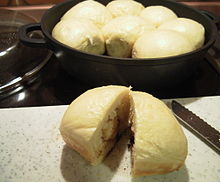
Dampfnudel
- Da Bao - An extra large version of the Chinese steamed bun. When translated, the name literally means big bun.
- Dampfnudel – A white bread roll or sweet roll eaten as a meal or as a dessert in Germany and in France (Alsace); a typical dish in southern Germany
F
- Finger Bun - A hot dog sized fruit bun with flavoured icing originating in Australia.
- Fruit bun – A sweet roll made with fruit, fruit peel, spices and sometimes nuts; a tradition in Britain[citation needed] and former British colonies including Jamaica, Australia,[12] Singapore,[13] and India[14]
H

Hot cross buns
- Ham and egg bun – A Hong Kong bun or bread that contains a sheet of egg and ham[15]
- Hamburger bun – A round bun designed to encase a hamburger; invented in 1916 by a fry cook named Walter Anderson, who co-founded White Castle in 1921[16]
- Heißwecke – A traditional type of currant bun that goes back, within the German-speaking region of Europe, at least to the Late Middle Ages
- Honey bun – A sweet roll of American origin, somewhat similar to the cinnamon bun, that is popular in the southeast United States
- Hoppang – A variant of jjinppang (Korean steamed bun)
- Hot cross bun – A sweet, spiced bun usually made with fruit but with other varieties such as apple-cinnamon or maple syrup and blueberries and marked with a cross on the top, traditionally eaten on Good Friday in the UK, Australia, New Zealand, South Africa, and Canada, but now popular all year round[17]
- Hot dog bun – A long, soft bun shaped specifically to contain a hot dog or frankfurter
I
- Iced bun – A bread roll that is made to a sweet recipe with an icing sugar glaze covering the top
J
- Jjinppang – A Korean steamed bun with red bean paste filling
L
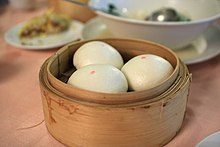
Lotus seed buns: This particular variety is available in many typical Cantonese restaurants as a type of dim sum.
- London bun – finger-shaped or elongated bun made of rich yeast dough flavored with either currants or caraway seeds and topped with white sugar icing
- Longevity peach - A type of lotus seed bun that is white with a red dyed tip with a crease along the side, mimicking the shape of a peach.
- Lotus seed bun – A Chinese sweet bun found in China, prepared by steaming a yeast-leavened dough that contains lotus seed paste[18]
M
- Manchet – A yeast bread of very good quality, or a small flat circular loaf of the same; small enough to be held in the hand.
- Mandarin roll – A steamed bun originating from China; cooked by steaming; a food staple of Chinese cuisine which is similar to white bread in western cuisine
- Mantou – A steamed bread or bun originating in China; typically eaten as a staple in northern parts of China where wheat, rather than rice, is grown
- Melonpan – A sweet bun from Japan, also popular in Taiwan, China and Latin America; made from an enriched dough covered in a thin layer of crisp cookie dough
- Momo - A type of South Asian dumpling, popular across the Indian subcontinent and the Himalayan regions of broader South Asia.
N
- Nikuman – A bun made from flour dough, and filled with cooked ground pork or other ingredients; a kind of chūka man (中華まん lit. Chinese-style steamed bun) also known in English as pork buns
P
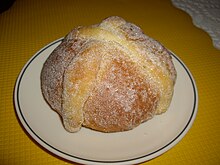
A piece of sugary pan de muerto
- Pampushka - A small savory or sweet yeast-raised bun or doughnut typical for Ukrainian cuisine.
- Pan de muerto – Spanish for "Bread of the Dead"; also called "pan de los muertos"; a sweet roll traditionally baked in Mexico during the weeks leading up to the Día de los Muertos, celebrated on November 1 and 2; a sweetened soft bread shaped like a bun, often decorated with bone-like pieces
- Pão de queijo - A Brazilian cheese bread, small, baked cheese roll, a popular snack and breakfast food in Brazil.
- Peanut butter bun – A Hong Kong sweet bun also found in Chinatown bakery shops;[19] it has layers of peanut butter filling, sometimes with light sprinkles of sugar mixed in for extra flavor
- Pets de sœurs – A sweet bun, similar in construction to a cinnamon bun.
- Pebete – An Argentine soft oval bun made of wheat flour with a thin brown crust,[20] rather like a fatter hot dog roll
- Penny bun – A small bread bun or loaf which cost one old penny at the time when there were 240 pence to the pound; it was a common size loaf of bread in England regulated by the Assize of Bread Act of 1266; the size of the loaf could vary depending on the prevailing cost of the flour used in the baking;[21] a version of the nursery rhyme London Bridge Is Falling Down includes the line "build it up with penny loaves"[22]
- Piggy bun – A Hong Kong pastry that is essentially the equivalent of the French baguette; found in Hong Kong bakeries and Cha chaan teng; in Hong Kong, it is often cut in half and served with butter and condensed milk[23]
- Pineapple bun – A sweet bun predominantly popular in Hong Kong and Macau,[24] though they are not uncommon in Chinatowns worldwide;[25] although it is known as "pineapple bun", the traditional version contains no pineapple
- Pork chop bun – famous and popular snack in Macau, the "piggy bun" is crisp outside and soft inside; a freshly fried pork chop is filled into it
R
- Rum roll - historic Washington D.C. specialty, similar to a cinnamon bun with rum flavored icing
S
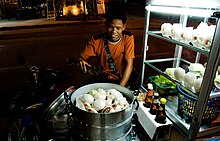
A street vendor in Chiang Mai, Thailand, selling various types of salapao
- Saffron bun – A rich, spiced, yeast-leavened sweet bun, flavored with saffron and cinnamon or nutmeg, and contains currants, similar to a teacake
- Sally Lunn bun – A enriched yeast bread associated with the city of Bath in the West Country of England
- Sausage bun – Hong Kong pastry, essentially the equivalent of pigs in a blanket; found in Hong Kong as well as in many bakeries in Chinatowns in western countries
- Semla – A traditional sweet roll made in various forms in Denmark, the Faroe Islands, Iceland, Estonia, Finland, Latvia, Lithuania, Sweden[26] and Norway; associated with Lent and especially Shrove Monday and Shrove Tuesday; the oldest version of the semla was a plain bread bun, eaten in a bowl of warm milk; in Swedish this is known as hetvägg
- Shengjian mantou - A type of small, pan-fried baozi which is a specialty of Shanghai and usually filled with pork and gelatin that melts into soup/liquid when cooked.
- Siopao – Hokkien term for bāozi (包 子), literally meaning "steamed buns";[27] it has also been incorporated into Thai cuisine where it is called salapao (Thai: ซาลาเปา)[28]
- Spiced bun – A sweet bun to which spices are added; common examples are the hot cross bun and the Jamaican spiced bun
- Sufganiyah - A deep-fried bun, filled with jam or custard, and then topped with powdered sugar. Typically eaten in Israel during Hanukkah.
- Sticky bun – A dessert or breakfast sweet roll that generally consists of rolled pieces of leavened dough, sometimes containing brown sugar or cinnamon, which are then compressed together to form a flat loaf corresponding to the size of the baking pan; they have been consumed since the Middle Ages, at which time cinnamon became more prominent[29]
T

A tuna bun filled with canned tuna
- Teacake - A fruited sweet bun usually served toasted and buttered.
- Tingmo - A steamed bread in Tibetan cuisine.[1] It is sometimes described as a steamed bun[2] that is similar to Chinese flower rolls. It does not contain any kind of filling.
- Tuna bun – A Hong Kong-style fish bun[30] that contains tuna paste; commonly found in Hong Kong[31]
W
- – A savory steamed bun filled with vegetables and meat. Literally means,"king dumpling" or "big dumpling".
X
- Xiaolongbao – A steamed bun from the Jiangnan region of China; fillings vary by region and usually include some meat and/or a gelatin-gelled aspic that becomes a soup when steamed
Z
- Zeeuwse bolus – A spiral shaped bun covered in dark brown sugar, lemon zest and cinnamon.
- Buns

Cha siu bao, filled with char siu pork

Norwegian skillingsbolle, type of cinnamon bun
A cross-section view of a cocktail bun, revealing the coconut filling

A cream bun
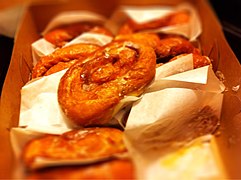
Honey buns

Mantou, a type of steamed bun

A sticky bun loaf
See also[]
- List of baked goods
- List of bread rolls
- List of British breads
- List of foods
References[]
- ^ Sutton, Henry. "The Bath Bun". Enjoy England. Retrieved 27 March 2010.
- ^ "What Is a Beef Bun". wisegeek.com. Retrieved 6 September 2012.
- ^ "Baked Beef Buns, "Cha Siu Bao" Style". thewanderingeater.com. Feb 12, 2010. Retrieved 6 September 2012.
- ^ Healy, Alison. "Waterford's blaa roll bakers honoured in awards", The Irish Times, Tuesday 18 November 2008.
- ^ How the Irish Invented Slang: The Secret Language of the Crossroads (Counterpunch) (Irish Edition)
- ^ Jump up to: a b Hsiung, Deh-Ta. Simonds, Nina. Lowe, Jason. [2005]. The food of China: a journey for food lovers. Bay Books. ISBN 978-0-681-02584-4. p24.
- ^ Elichondo, Margarita: La comida criolla: Memoria y recetas. Popular Culture Library, Editions of EL SOL, 2003 (ISBN 950-9413-76-3) (Restricted online copy at Google Books)
- ^ "Ministry of Social Development (President of Argentina): "Sabores con sapucay", Rescatando lo autóctono desde la historia familiar" (PDF). Archived from the original (PDF) on 2011-09-03. Retrieved 2013-05-26.
- ^ Kathryn Hawkins The Food of London: A Culinary Tour of Classic British Cuisine, Singapore: Periplus Editions (HK) Ltd, 2002, p.26
- ^ Alan Davidson "Bun" in The Oxford Companion to Food Oxford University Press, 1999, p. 114 ISBN 0-19-211579-0
- ^ "Chinese Bakery". ChinatownConnection.com. Retrieved 12 August 2012.
- ^ Newscorpaustralia.com Archived August 7, 2011, at the Wayback Machine
- ^ "Using bread improver". Archived from the original on 2 November 2012. Retrieved 22 April 2016.
- ^ "Best before date of food items is date of expiry". The Indian Express. February 1, 2009. Retrieved April 22, 2016.
- ^ "秘製香軟火腿煎蛋包(Chinese)". 頭條日報. hkheadline.com. 2012-10-24. Retrieved 15 January 2014.
- ^ "h2g2 - Hamburgers in History". Bbc.co.uk. Retrieved 2013-10-27.
- ^ "BBC News - How did hot cross buns become two a penny?". Retrieved 22 April 2016.
- ^ Chang, Norma (2001). My Students' Favorite Chinese Recipes. The Travelling Gourmet. p. 28. ISBN 9780961875947. Retrieved May 8, 2012. ISBN 0961875941
- ^ "Chinatown's Hong Kong Bakery - Grub Street Philadelphia". Blogs.menupages.com. 2007-12-21. Retrieved 2013-10-15.
- ^ RAE - ASALE. "Diccionario de la lengua española - Edición del Tricentenario". Diccionario de la lengua española. Retrieved 22 April 2016.(in Spanish)
- ^ Randal W. Oulton. "Penny Loaf Day". Practicallyedible.com. Archived from the original on 2012-02-25. Retrieved 2013-05-26.
- ^ "National Institute of Environmental Health Sciences - Kids Pages - London Bridge". Kids.niehs.nih.gov. 2010-12-15. Archived from the original on 2013-05-20. Retrieved 2013-05-26.
- ^ "香港茶餐廳10款經典飲食(10)(Chinese)". 香港成報. 2013-07-09. Retrieved 2013-07-12.
- ^ "Hong Kong food: 40 dishes we can't live without - 6. 'Pineapple' bun". CNN Travel. 13 July 2010. Retrieved 5 January 2014.
- ^ "What Is a Pineapple Bun". wisegeek. Conjecture Corporation. Retrieved 5 January 2014.
- ^ "Semlor". recepten.se. Retrieved 22 April 2016.
- ^ Frances Lorraine Haw-Ang (August 25, 2010). "Top 10 Siopao in Manila". Spot.ph. Retrieved 21 December 2010.
- ^ "Salapao – Chinese Steamed Buns". Thaizer.com. January 15, 2010. Retrieved 21 December 2010.
- ^ Walter, Carole (2007). Great Coffee Cakes, Sticky Buns, Muffins & More. Random House LLC. p. 183. ISBN 978-0307237552.
- ^ Qiu, Yongling (2011). 港麵包 港味道 (Popular bread in Hong Kong). 萬里機構 (Wan Li Book). p. 92. ISBN 9789621446473.
- ^ "Local Bakery". Archived from the original on 5 February 2014. Retrieved 29 January 2014.
Categories:
- Buns
- Quick breads
- Sweet breads
- Yeast breads
- Lists of breads








